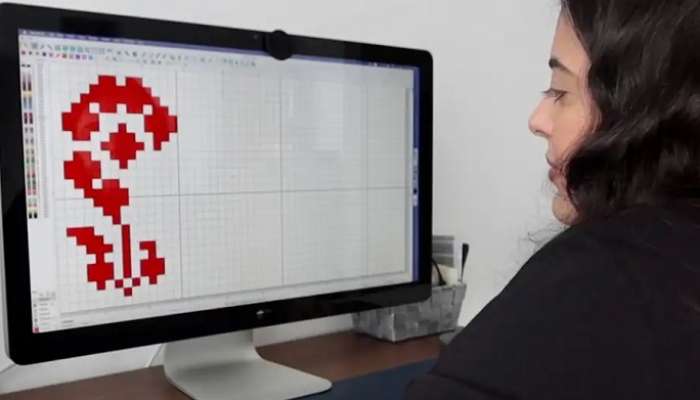
Zain Masri still remembers the vibrant feeling of completing her first cross-stitched motif at the age of 7. "For years, it remained my favorite holiday activity at my grandmother's place in Jordan," the 31-year-old told DW.
Masri, who works in marketing in Dubai, reconnected with her family tradition of cross-stitching Palestinian patterns during the pandemic. "I joined online embroidery communities for inspiration while spending lots of time at home," she said. Masri quickly realized, however, that a shortage of high-resolution patterns was one of the main challenges for the global embroidery community.
"There should be a place for digitalized, printable and freely available patterns as this is cultural heritage," Masri thought and wondered why she should be waiting for someone to launch such a database.
And so, some 24 years after her grandmother introduced her to Tatreez, which is the Arabic term for this traditional type of Middle Eastern needle work, Masri started Tirazain, the first digital embroidery database of traditional Palestinian cross-stitching patterns including the information on their origin and aesthetic features. Typical examples are palm trees, jagged patterns in different colours or patterns that resemble tiles on the Noble Sanctuary or Haram al-Sharif in Jerusalem.
Only, creating such a database turned out to be much more time-consuming than expected. Since none of the existing digitization software options were accurate enough to decipher the stitches automatically, Masri started to break down motifs manually on digital grids.
"I've spent thousands of hours digitalizing motifs stich by stitch," she said, adding that this makes them printable for manual cross-stitching and downloadable for machine embroidery.
Meanwhile, around 1,000 such patterns are available for download on her database, which has been slowly growing since October 2021 and was only officially launched this summer. Her breakdown of statistics show that already more than 1,000 people access the patterns every day, and the community is growing.
Palestinian embroidery: 'Intangible cultural heritage'
While cross-stitching on dresses and fabrics has a long tradition throughout the Middle East, with the earliest findings dating back to ancient Egypt, Palestinian embroidery carries additional significance. This was recognized by the United Nations Educational, Scientific and Cultural Organization, or UNESCO, who put the art of Palestinian embroidery on the Representative List of the Intangible Cultural Heritage of Humanity in 2021.
"In the Palestinian culture, embroidery was always used as a story-telling technique," Masri said, adding that "according to the embroidery and the color of the thread, you could tell exactly where a woman is from, if she is single, married, if she has children, is divorced or if she is a widow."
For example, when a woman got married, her main, and often only, dress was embroidered with a red thread. Then, when the woman got pregnant, the same dress was temporarily altered with fabric patches on the sides, and later cut around the chest during the period of breast feeding. Each alteration was complemented by cross-stitching.
"When the woman got divorced or became a widow, motifs in darker colors were added and, over time, this dress depicted her personal life story," Masri said. "These dresses have become family treasures as they tell the story of the women in the family."
Menswear, however, never really carried the same traditional embroidery. The only exception was an embroidered handkerchief what was usually prepared by the future wife for the groom.
Other typical embroidered items of the dowry were pillow covers or decorative items for the household. Zain Masri, who was born in the United States, happily points to her two cross-stitched pillows on the sofa in her living room. "I love textile art and these are just so beautiful," she said.
Award-winning women empowerment
While Tirazain is Zain Masri's first private passion project, which won Bronze for the Best Community Engagement in Education, Art and Culture at this year's Anthem Awards, it is not the first time that her projects that promote digital literacy and economic empowerment for Arab women have gained attention.
For example, her digital skills education program "Maharat min Google" (Building capabilities with Google) has reached almost two million people in the Middle East, and her YouTube Balata project, a content hub that features hundreds of women entrepreneurs in the Arab World, is widely acclaimed in the Arabic speaking region. Over the past couple of years, Zain, who moved to Dubai in 2009, was selected to the Forbes 30 Under 30 list, and the Arab America Foundation 30 Under 30 list. She has also been appointed a UN Women Advocate and an IMF Youth Fellow.
Her two grandmothers in Jordan have many reasons to be proud of her.
"I know that for them, understanding the database is far-fetched, but when I showed them some of my finished pieces, they immediately connected with the patterns," Masri said, adding that "our family tradition lives on, online and offline."